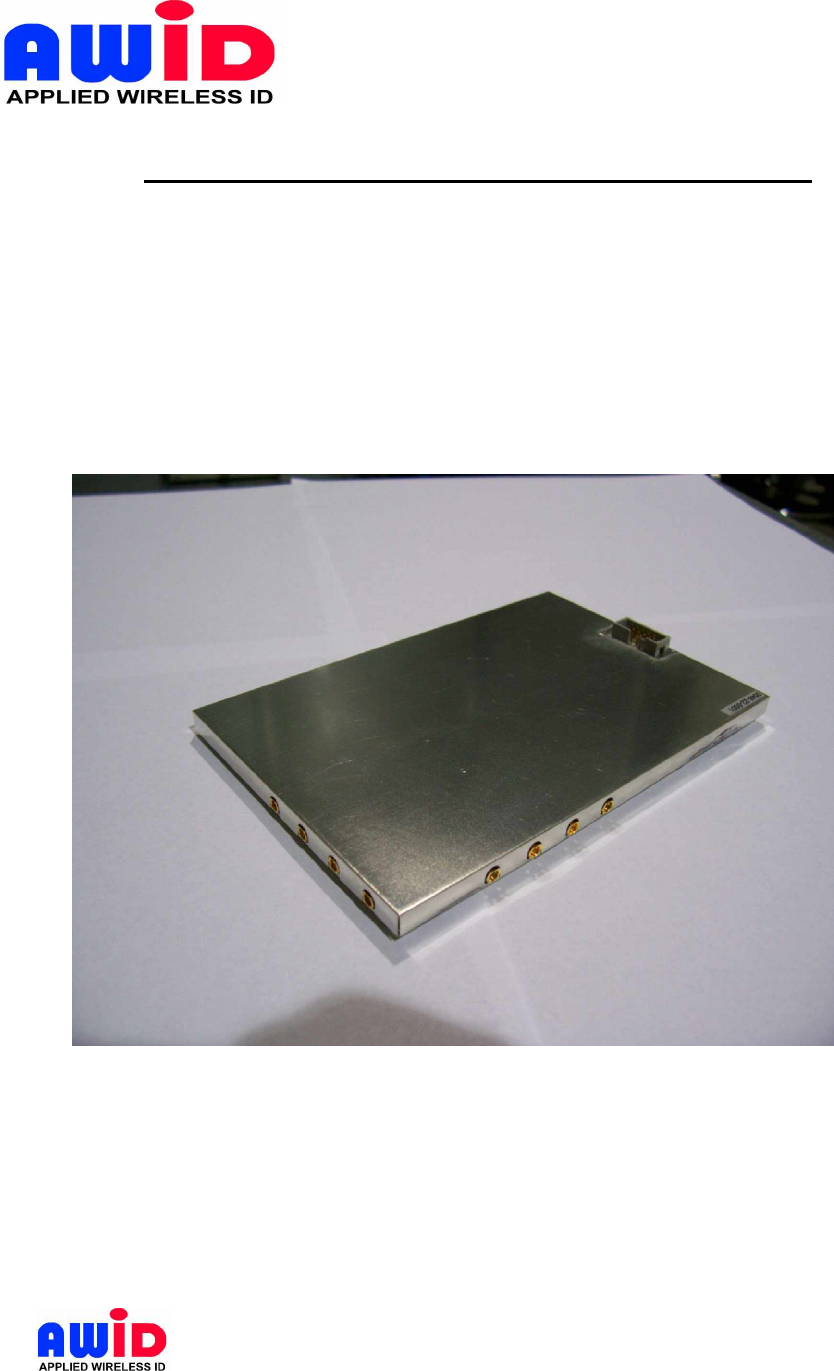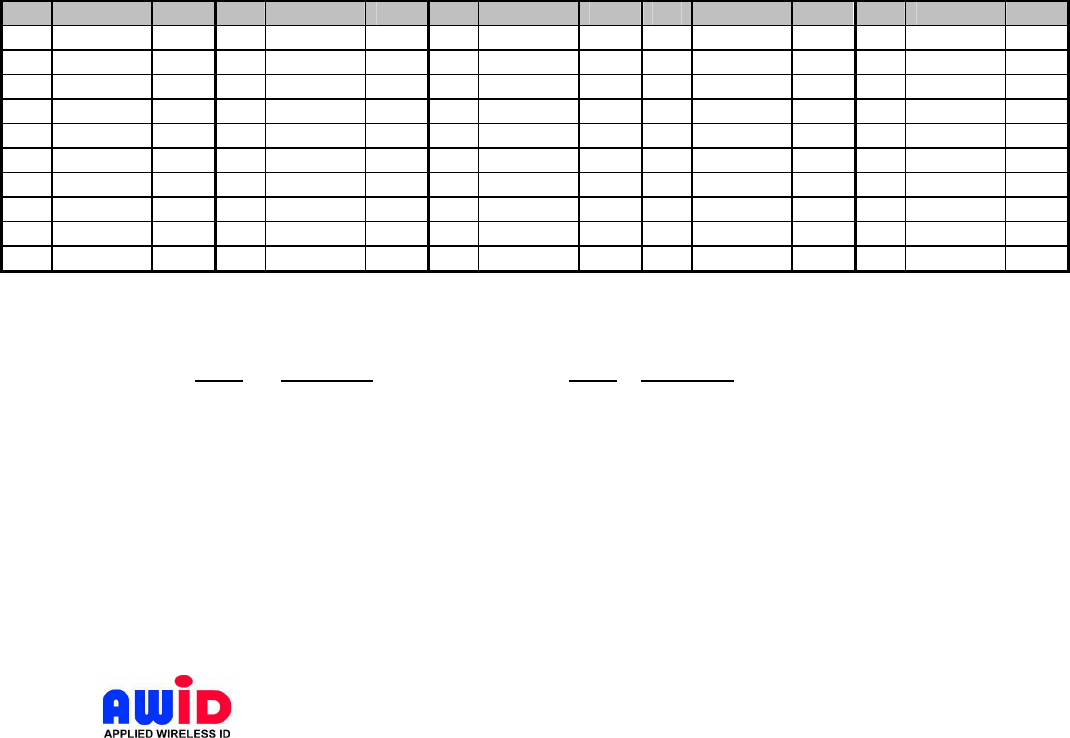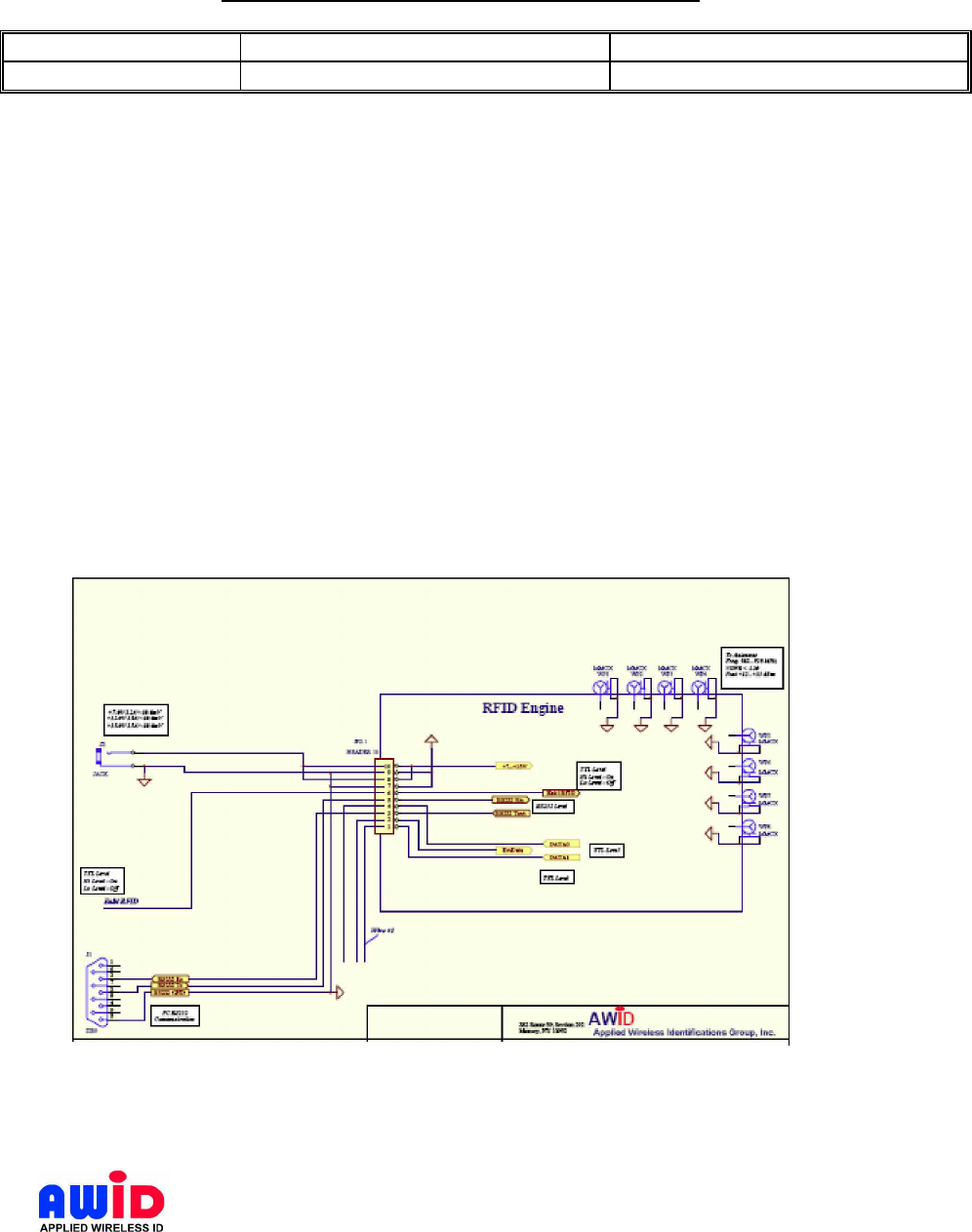Applied Wireless Identifications Group M32EA MODULE User Manual USERS MANUAL
Applied Wireless Identifications Group Inc. MODULE USERS MANUAL
USERS MANUAL

MPR-1510 3.2x - 1 - Doc# 041313
AWID PROPRIETARY
SENTINEL-SENSE MPR-1510
3.2x
Installation & Operation Manual

MPR-1510 3.2x - 2 - Doc# 041313
AWID PROPRIETARY
COPYRIGHT ACKNOWLEDGEMENTS
The contents of this document are the property of Applied Wireless Identifications Group, Inc.
(AWID) and are copyrighted. All rights reserved. Any reproduction, in whole or in part, is
strictly prohibited. For additional copies of this document please contact:
AWID
18300 Sutter Blvd
Morgan Hill, CA 95037
www.sales-ast@AWID.com
The information contained herein has been carefully checked and is believed to be accurate,
no responsibility is assumed for inaccuracies. AWID reserves the right to make changes
without prior notice. This document is not covered by any warranty either expressed or
implied. Any comments, corrections or additions to the contents of this document should be
directed to AWID at the above address.
Copyright 2006 AWID, Printed in USA.
All other trademarks are the property of their respective owners.
FCC COMPLIANCE
This equipment has been tested and found to be in compliance with the limits for FCC Part 15,
Class A digital device. These limits are designed to provide reasonable protection against
harmful interference when the equipment is operated in a commercial environment. This
equipment generates, uses and can radiate radio frequency energy and, if not installed and
used in accordance with instruction manual, may cause harmful interference with radio
communications. Operation of this equipment in a residential area is likely to cause harmful
interference in which case the user will be required to correct the interference at his own
expense.
The users are prohibited from making any change or modification to this product, any
modification to this product shall voids the users authority to operate under FCC Part 15
Subpart A Section 15.21 regulations.
This device complies with Part 15 of the FCC Rules. Operation is subject to the following
two conditions: (1) This device may not cause harmful interference and, (2) this device must
accept any interference received, including interference that may cause undesired
operation.
The antenna(s) used for this transmitter must not be co-located or operating in
conjunction with any other antenna or transmitter.
INDUSTRY C ANADA C OMPLIANCE
Operation is subject to the following two conditions: (1) this device may not cause
interference and (2) this device must accept any interference, including interference that
may cause undesired operation of the device.

MPR-1510 3.2x - 3 - Doc# 041313
AWID PROPRIETARY
This device has been designed to operate with the antennas listed below, and having
a maximum gain of 10 dBi. Antennas not included in this list or having a gain greater
than 10 dB are strictly prohibited for use with this device. The required antenna
impedance is 50 ohms.
1) Mti, model MT-263003/N; 10 dBi Linear polarization directional antenna
(Patch)
2) Snyder Antenna Systems, part # ANT-UHF-1x4-SMA; 2 dBi Dipole antenna
(Dipole)
3) AWID, model HYBRID 915MHz; 6 dBi Circular polarized antenna (Patch)
4) Mti, model MT-262002/N/A; 8 dBi Linear polarization directional antenna
(Patch)
To reduce potential radio interference to other users, the antenna type and its gain
should be so chosen that the equivalent isotropically radiated power (EIRP) is not
more than that required for successful communication.
C AUTION:
Reader should be positioned so that personnel in the area for prolonged periods may
safely remain at least 23 cm (9 in) in an uncontrolled environment from the readers surface.
Observe FCC OET Bulletin 56 Hazards of radio frequency and electromagnetic fields and
Bulletin 65 Human exposure to radio frequency electromagnetic fields.

MPR-1510 3.2x - 4 - Doc# 041313
AWID PROPRIETARY
Table of Contents
1INTRODUCTION.......................................................................................................5
1.1 Special Features ................................................................................................ 5
2SPECIFICATIONS ....................................................................................................6
2.1 Channel Frequency Table..................................................................................6
2.2 Connector Pin Assignment.................................................................................6
2.3 Measuring Read Distance..................................................................................6
3INSTALLATION & OPERATION GUIDELINES .......................................................8
3.1 Site Survey.........................................................................................................8
3.2 Preferred Reader Installation Practices .............................................................8
3.3 Mounting Preference.......................................................................................... 8
3.4 General Wiring Requirements............................................................................8
3.5 Grounding ..........................................................................................................9
3.6 Wiring Diagrams ................................................................................................9
4INSTALLATION PROCEDURE ..............................................................................10
4.1 Parts List.......................................................................................................... 10
4.2 Preparation for Installation ...............................................................................10
4.2.1 Bench Top Verification..............................................................................10
4.2.2 Antenna Pattern ........................................................................................10
5SOFTWARE PROGRAMMING AND SYSTEM OPERATION NOTES...................12
5.1 System Operation ............................................................................................ 12
5.1.1 Running a Custom Software Application or the AWID Demo Program.....12
5.1.2 Operating Modes ......................................................................................12
5.2 Users Note....................................................................................................... 12
6MPR 3014 PROTOCOL..........................................................................................13
NOTE: READ AND USE THIS MANUAL.
FAILURE TO FOLLOW THE INSTALLATION GUIDE MAY RESULT IN POOR
PERFORMANCE OR EVEN CAUSE PERMANENT DAMAGE TO THE READER,
THUS VOIDS THE PRODUCT WARRANTY.

MPR-1510 3.2x - 5 - Doc# 041313
AWID PROPRIETARY
1 INTRODUCTION
AWID's Sentinel-Sense MPR-1510 3.2x is a long-range (12 to 15 feet) Radio Frequency
IDentification (RFID) reader module with RS-232 I/O interface that works with most
leading passive UHF passive tags. This reader comes with a unique combination of long
read range, small size, and low power consumption. The reader module has an internal
power converter, allowing it to work with a wide range of supply inputs without affecting
its performance. Its primary applications are asset management and tracking, and fleet
management applications.
The MPR-1510 3.2x reader modules are delivered with the following:
qMPR-1510-RM 3.2x REV: E with firmware version 5.xxN
In order to operate an MPR-1510 3.2x you will need the following:
qStandard antenna(s) each with 10dBi gain or less
qPC running Windows1 98 or higher, CD-ROM drive and one RS-232 serial port.
qHost software (AWIDs demo software or your own custom software)
qRFID Tags (EPC Class 0, 1, ISO Type B, etc)
1.1 SPECIAL FEATURES
· Multi-Protocol: ISO-18000-6 Type A/B, EPC Class 12, Gen 1 & 2, EPC Class03,
EPC V1.19 Rev.2
· Thin passive tags with long-range performance
· RS-232 outputs
·
1 Though MPR-1510 3.2x can also be controlled from a non-Windows programming platform, AWID demo
and FW upgrade programs are applications to run in Windows.
2 Both 64- and 96-bit
3 Both 64- and 96-bit

MPR-1510 3.2x - 6 - Doc# 041313
AWID PROPRIETARY
2 SPECIFICATIONS
Input voltage +7.0 VDC to +15 VDC
Input current 1.0 A (7.0 V) to 0.40 A (15 V) typical
Protocol language ISO Type B, EPC Class 1 Gen 1 & 2, EPC Class 0,
EPC V1.19 Rev.2
Read range Depends on type & size of labels used
Output power 0.383 Watt into 10 dBi antenna
Transmit frequency 902-928 MHz
Receiver frequency 902-928 MHz (Amplitude Modulated)
Hopping channels 50 Channels
Channel spacing 500 kHz
Hopping sequence Pseudo random
Operating temperature range -30° C to +65° C (-22° F to 149° F)
Output data formats RS-232 Version:
I/O Connector DB-9 connector
Dimension x6x0.25
2.1 CHANNEL FREQUENCY TABLE
Frequency range: 902 ~ 928 MHz
Minimum Number of frequency channels: 50
CH 902~928 MHz CH 902~928 MHz CH 902~928 MHz CH 902~928 MHz CH 902~928 MHz
0 902.75 MHz 10 907.75 MHz 20 912.75 MHz 30 917.75 MHz 40 922.75 MHz
1 903.25 MHz 11 908.25 MHz 21 913.25 MHz 31 918.25 MHz 41 923.25 MHz
2 903.75 MHz 12 908.75 MHz 22 913.75 MHz 32 918.75 MHz 42 923.75 MHz
3 904.25 MHz 13 909.25 MHz 23 914.25 MHz 33 919.25 MHz 43 924.25 MHz
4 904.75 MHz 14 909.75 MHz 24 914.75 MHz 34 919.75 MHz 44 924.75 MHz
5 905.25 MHz 15 910.25 MHz 25 915.25 MHz 35 920.25 MHz 45 925.25 MHz
6 905.75 MHz 16 910.75 MHz 26 915.75 MHz 36 920.75 MHz 46 925.75 MHz
7 906.25 MHz 17 911.25 MHz 27 916.25 MHz 37 921.25 MHz 47 926.25 MHz
8 906.75 MHz 18 911.75 MHz 28 916.75 MHz 38 921.75 MHz 48 926.75 MHz
9 907.25 MHz 19 912.25 MHz 29 917.25 MHz 39 922.25 MHz 49 927.25 MHz
2.2 CONNECTOR PIN ASSIGNMENT
Pin# Function Pin# Function
1 Data 1 6 Enable RFID
2 Ext Data in 7 Ground
3 RS232 Tx 8 +7V/+15V
4 Data 0 9 Ground
5 RS232 Rx 10 +7V/+15V
2.3 MEASURING READ DISTANCE

MPR-1510 3.2x - 7 - Doc# 041313
AWID PROPRIETARY
Make sure you know the tag types. For certain readers and tags, user must also be
mindful of the tags orientation and the readers antenna orientation, what mounting
surface the tags are designed for and how the tags are supposed to be mounted. Any
departure from its intended purpose will drastically affect the readers ability to energize
the tag and its read range.
When measuring the readers read range, make sure that the tag is properly oriented to
the reader antenna, and for optimum performance, be sure the operators finger is not
within three (3) inches of the tags antenna surface.

MPR-1510 3.2x - 8 - Doc# 041313
AWID PROPRIETARY
3 INSTALLATION & OPERATION GUIDELINES
For ease of explanation, MPR reader in this section refers to an MPR-3014 reader
model, i.e., a unit that consists of MPR-1510 (3.2e) inside a splash proof, UV
stabilized housing case and high performance circular polarized antenna(s).
3.1 SITE SURVEY
Always conduct a site survey before starting installation. Avoid any possible sources of
interference. For best result, use a spectrum analyzer with a wideband antenna and set
the spectrum analyzer in Max Hold mode to gain measurement of the maximum signal
strength on the airwave. If the MPR reader is not installed properly, the performance will
be degraded. Listed below are steps that should be followed during installation:
· Do not install the MPR reader in an area where sources of broadband noise may
exist. Avoid mounting the reader facing a cellular phone tower or in close proximity
to the base station of a 900 MHz wireless telephone.
· Keep all of the MPR reader wiring a safe distance from all other wiring, including,
but not limited to, AC power, computer data wiring, and telephone wiring, and wiring
to electrical locking devices.
· Avoid operating the MPR reader in close proximity to other 900 MHz wireless
local area networking (WLAN) equipment. It should be noted that MPR-2010s (, etc.
are known to work in electromagnetic crowded areas, such as trade shows.
3.2 PREFERRED READER INSTALLATION PRACTICES
· Avoid mounting the MPR reader under direct sunlight. Exposure to direct sunlight
may cause the reader to operate at a temperature above the 65 degrees Celsius
upper limit.
· Make sure that the supply voltage of the MPR reader is within specification
· Use cables with over-all shield (screen)
· For best results, avoid bundling data cable with AC power and computer cables
· Use the largest wire gauge where feasible
· Use dedicated power supply, where necessary
· Use Single Point Grounding, and avoid ground loops
3.3 MOUNTING PREFERENCE
An MPR-3014 reader uses uni-directional antennas each with an antenna beam width of
about 60-70 degrees. The radiation pattern is an oval-shaped beam, which should be
aimed toward where the transponders will pass.
3.4 GENERAL WIRING REQUIREMENTS
All the MPR reader wiring should be continuously shielded. AWID recommends using
#24 AWG up to #22 AWG, longer distances and higher current consumption on the

MPR-1510 3.2x - 9 - Doc# 041313
AWID PROPRIETARY
power supply line will require larger gauge wires. PG I/O output are standard access
industry Wiegand drivers, which is capable of 500 feet driving distance.
TABLE 3.4-1: Data Lines Wiring Requirement
WIRE SIZE #22 AWG (0.6 mm Dia.) #24 AWG (0.5 mm Dia.)
RS-232 50 ft (15 meters) 50 ft (15 meters)
3.5 GROUNDING
Grounding is critical for proper operation of MPR-1510. When installing the readers, it is
crucial to assure that the earth ground is the best ground available. If you elect to use
the 120 VAC power ground, conduct a test by measuring its resistance relative to a
known good ground, such as a cold water pipe or structural steel that is in direct contact
with the ground. The resistance should be less than 50 ohms.
3.6 WIRING DIAGRAMS
See section 2.1 for pin assignment for the RS-232 connector of an MPR-1510 3.2x.
The MPR RS-232 interface is a short distance serial interface, a full command set for
the standard serial interface is not necessary, therefore only transmit, receive and
ground wires are used. Sense input is an enable input, which is traditionally used to
activate the RF energy of the reader and to start the read functions.

MPR-1510 3.2x - 10 - Doc# 041313
AWID PROPRIETARY
4 Installation Procedure
This section provides installation and operation information for MPR readers.
4.1 PARTS LIST
Verify that all items listed below are present before starting the installation.
o Sentinel-Sense MPR-1510 reader module 3.2x Qty=1
o Documentation and Demo Program CD Qty=1
4.2 PREPARATION FOR INSTALLATION
Familiarize yourself with the connectors and pin out assignment of each I/O connectors.
4.2.1 Bench Top Verification
It is always a good idea to verify system operation before committing to a full-scale
installation. The following are the necessary steps to test the readers operation in a
static environment.
qConnect MPR reader module to the RS-232 port of a PC
qConnect power (via the power jack from a wall plug power supply) to the MPR
reader module
qConnect Antenna(s)
qPower up PC
qInstall demo software on PC
qActivate demo software and verify performance of the reader.
qSelect COM port 1 on top page then click Connect. Follow with some
commands.
qPlace the RFID tags at the exact same locations as the final configuration
qMeasure tags read distance and confirm that read distance is correct.
4.2.2 Antenna Pattern
MPR-1510 performs best with a circular polarized antenna to ensure reading tag with
random orientation. Most circular polarized antenna has a horizontal to vertical
differential of up to 3 dB, this will cause the antenna pattern to deviate from a true circle.
AWIDs antenna used with MPR-3014 readers has a horizontal to vertical differential of
typically less than 0.5 dB, making its pattern as near to a circle as possible.
· Antenna pattern measurements represent both horizontal and vertical polarized
planes of the read area transmitted by the reader.
· In the drawing below, R = approximately 12 feet to 15 feet with Alien free space
tags.
· Antenna pattern can be affected by RFI and other environmental conditions.

MPR-1510 3.2x - 11 - Doc# 041313
AWID PROPRIETARY
0.15 00.25 0.5
0.75
R
0
Distance (R)
Width(W)
W (0.72R)
Figure 3 Antenna Pattern

MPR-1510 3.2x - 12 - Doc# 041313
AWID PROPRIETARY
5 SOFTWARE PROGRAMMING AND SYSTEM OPERATION NOTES
5.1 SYSTEM OPERATION
5.1.1 Running a Custom Software Application or the AWID Demo Program
If AWID Demo Program is not used, it is expected user will launch a Custom Software
Application developed using the MPR 3014 Protocol for issuing commands as specified
to the reader.
5.1.2 Operating Modes
Typical operating modes for MPR readers can be grouped into the following modes:
Search Mode
This mode is used when operator or user is not certain what family of tags are placed on
the items to be tracked. Since most tags are deterministic in nature, MPR reader must
cycle through each and every protocol, issue a protocol specific inquiry, to hail and to
wait for a response from tags of that specific protocol. Therefore, if there are many
different protocols, for an untrained observer, the reader response will appear sluggish.
Mixed Mode
This mode assumes the user is aware of the types of protocol in use, and furthermore, the
user made a determined effort to operate the reader in a mixed protocol mode. In this
mode, the user can decide how many and which specific protocols to be selected. Once
Mix Protocol Mode is selected, the reader will routinely cycle through each protocol, dwell
long enough for the reader to wait for a response and then move on to the next protocol. It
should be noted that in a mixed protocol mode, the tag must have sufficient time to
respond to the reader, and therefore, it can only be used on a conveyor belt arrangement,
with specific speed restrictions.
Single Protocol Mode
Single protocol is the normal mode of operation, where the protocol type is known and
many tags are expected to pass through the readers.
5.2 USERS NOTE
For System Integrators and/or Software Developers
System Integrators and/or Software developers should get familiar with the MPR 3014
Protocol specifications for developing applications that control MPR-1510 3.2x modules.
For Custom System Users
For custom system user, please refer to your host software user guide for information
regarding system and software operations
For Demo Software Users

MPR-1510 3.2x - 13 - Doc# 041313
AWID PROPRIETARY
If you are using the AWID RFID demonstration software application which is .NET based
with easy-to-follow GUI operations, simply select the COM port for which the MPR
reader module is configured then click Connect should get you started.
6 MPR 3014 PROTOCOL
See MPR 3014 Protocol Manual - 041310